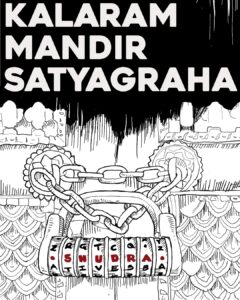Bahujan deities around the subcontinent did not concern themselves with the ideas of sacredness, nor with notions of purity. Nature was central to Bahujan spirituality.

Illustration by Ajinkya Dekhane
Bahujan deities around the subcontinent did not concern themselves with the ideas of sacredness. Subaltern oral traditions are filled with stories of natural elements deified. Often elements of nature are personified and given status of kin. This points out the centrality of nature and material reality in Bahujan spirituality. As in the case of Khetarpal, often referred to as Kshetrapal by the Dwija Hindus, materiality remains in the center of its story. Khetarpal is the deity resembling the form of a serpent who guards the farmland against pests. For a very long time, Khetarpal was worshipped independently by peasant and farmer castes until Dwijas cleverly incorporated Khetarpal into the Hindu pantheon by subordinating it to the Hindu deity Shiva.
“The cultural, economic, and political ethos of the Dalitbahujan Goddesses/Gods is entirely different from Hindu hegemonic Gods and Goddesses. The Dalitbahujan Goddesses/Gods are culturally rooted in production, protection, and procreation...War and violence are not at all central to the philosophical notions of the people. Ritualism is a simple activity that does not involve economic waste. The Hindu Gods are basically war heroes and mostly from wars conducted against Dalitbahujans in order to create a society where exploitation and inequality are part of the very structure. The Hindus have male-centered mythology and women are restricted to gender-specific roles and rendered sexual objects.”
Kancha Illaiah, Why I am not a Hindu.
In Gulamgiri, Jotiba talks about Khandoba of Jejuri who was one of the Chieftains of Mahabali. Calling him the friend of the downtrodden, he says,
“...The Khandoba of Jejuri (Western Maharashtra) was one of them. He used to quell the rebellious Mallas (Wrestlers) of the neighboring satraps and hence he was called `Mallaari (i.e. enemy of the Mallas). Malhari is a corrupted form of this title. He used to observe the rules of warfare strictly such as not hitting the retreating warriors on their backs i.e. he always hit them on their front or faces. Hence, he came to be known as `the front (mouth)' i.e. Martand.”
In his book Revolution and Counter-Revolution, Bodhisattva Babasaheb describes how Buddhist history was co-opted and plundered by the brahmanic counter-revolution. He explains in detail the intensity of attacks carried out by Brahmins against the Buddhists. While unveiling an image of Buddha in Poona, he said that the image of Vithoba in Pandharpur was actually that of Buddha. He explained that the name of the god has been derived from the word Pundalik which means lotus. Lotus in Pali was called Pandurang.
Devi pooja is often invoked to sanctify Hindu social structure as a feminist one. But was devi pooja universal to the whole subcontinent? Kancha Illaiah suggests that “the number of Goddesses is more than that of Gods in the Dalitbahujan narratives.” These goddesses are independent, ferocious, and concern themselves with the everyday life problems of their devotees. They are not subordinated by any consort gods who would bless them with powers.
The Goddesses in Hindu traditions like Durga need a constant lower caste enemy for their deification. War and violence are recurring themes in their myths. While on the other hand, Dalit Bahujans have goddesses like Pochamma- the mother who looks after the sick, Kattamaisamma- who regulates the water resources, and Sarakka- the one who protected her tribal village from invasions. Here, the central theme is love, care, and resistance.
Many of the deities who are worshipped today by lower caste communities were our ancestors who fought against brahmanical onslaught. Many temples found today stand on the remnants of Buddhist architecture. Our goddesses never had a superior husband-like figure. Our gods did not concern themselves with notions of purity. Our interactions with them would look like a familial affair. Thousands of years of colonization of our land has resulted in appropriation, and erasure of our ancestral knowledge. The responsibility to unearth a debrahminized history has been passed on to us now.
Sources:
B.R. Ambedkar – Dr. Babasaheb Ambedkar, Writings and Speeches: Vol. 17 Part 3
Kancha Illaiah – Why I am not a Hindu
Jotiba Phule – Gulamgiri




